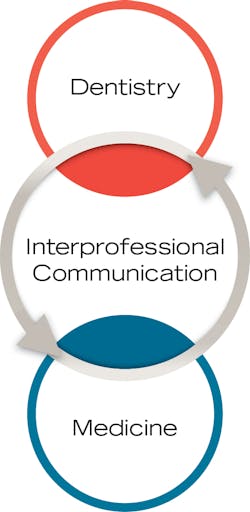The medical-dental-patient gap: Building relationships for optimal patient outcomes
As the number of dental hygiene Facebook groups continues to increase, so does the opportunity for dental hygienists to utilize social media platforms to engage in conversations with other RDH professionals. We can list employment concerns, search for treatment opinions and product advice, vent about scheduling issues, ask for guidance in the resolution of our bodies’ aches and pains, and ask others for ways to rectify patients’ neglect in informing us of medical issues during the medical history update.
As this is just a small sample of the conversations that appear on the array of dental hygiene professional pages on Facebook, a recurring theme emerges from the multitude of daily posts. Hygienists’ frustrations are evident in the tone of recurring posts about patients neglecting to provide a full and truthful account of their current medical status. These patients are seen day after day with critical physiological conditions that can create grave situations with infection or ailments directly related to a prophylaxis or SRP hygiene appointment. The emotion comes through on each post as hygienists are placed in alarming situations when hearing a patient note in general conversation at the end of the appointment:
- “I just got out of the hospital last week from heart valve replacement surgery.”
- “I’m doing pretty well since my stroke last month.”
- “Can you tell I’m moving better since I had my total knee replacement?”
The medical-dental-patient gap
Even as we contemplate why patients fail to give us an accurate report of their medical conditions, many reasons might be noted. Have patients forgotten about the recent changes in their medical history? Are they just ignoring the questions? Do they simply refuse to answer? Are they unaware of the potential risks involved with the treatment modalities of a dental hygiene appointment and some medical conditions?
When dealing with this aspect of the appointment, we feel frustration that many patients disregard the importance of the medical history update. After all, it’s just a teeth cleaning! Here are a couple of recent post comments from the Dental Hygiene Network Facebook page.
One patient notes to his RDH at the end of his appointment that he was in the middle of chemotherapy for stage 4 lung cancer. Another admits (again at the end of the appointment after denying any change in medical history) that she had to have a kidney transplant and her son was her donor. Upon further questioning by the hygienist, the patient relayed the story of how she was only four months post-op from her kidney transplant.
Related reading:
These are just a few examples of the issues hygienists face daily regarding a patient’s compromised medical history. These conditions are outside of the scope of practice for dentistry and dental hygiene and would need a medical professional referral or release to treat consultation prior to proceeding with dental care. Communication between the two health-care providers is essential in the provision of a medical clearance and to validate that continuation of dental treatment is safe. However, in the fast-paced world of medicine and dentistry, it may not always be conducive to obtain the needed medical release/referral in a timely manner. How can we, as medical and dental professionals, fix this gap in communication?
“In 2009, the American Dental Education Association, in collaboration with five national health professional education associations, established the Interprofessional Education Collaborative (IPEC) to promote the establishment of interprofessional training and team-based care.”1 The IPEC developed a set of core competency domains for interprofessional collaborative practice,1 which include:
- Values/ethics
- Roles/responsibilities
- Interprofessional communications
- Teams and teamwork
A team-based approach
This concept is a team-based approach to care that draws upon the shared knowledge of health-care professionals to deliver better care. This model of communication could improve the quality of care a patient receives when the whole-person mode of patient treatment is the focus. The link between oral health and overall health is a concept the World Health Organization endorses. There are proven oral-systemic links with low-birth-weight babies, diabetes, heart disease, stroke, osteoporosis, respiratory illnesses, and hypertension. Additionally, severe advanced periodontal disease and the occurrence of cardiovascular disease have a proven correlation.
“As the advanced practice for dental hygiene emerges, it is imperative that the educational qualifications of dental hygiene are sufficient to enable them to safely provide the scope of services and care encompassed in these new expanded roles to effectively participate as an interprofessional team member.”2
“The Commission on Dental Accreditation (CODA) Dental Hygiene Standard 2 – 20 emphasizes that graduates from academic dental institutions and dental hygiene programs meet competencies in effective communications, understanding the social determinants of health and collaborate with other members of the health-care sector in the provision and support of patient care.”1
Moving from autonomy to collaboration
Successful collaboration can occur when there is an understanding of the individual roles and expertise of other health-care professionals. To facilitate collaborative relationships, it may be time for professional dental and health-care societies to incorporate a process for integration of a shared dental-medical telemedicine site where communication between disciplines can occur. Successful interdisciplinary collaboration may require creativity to establish a model of care that identifies all possible stakeholders involved in patient care.
“It is imperative not only for the patients to share their medical history and medications with any other health-care provider they are interacting with, but also it is important for the medical and dental fraternity to understand the role of integrated patient care.”3 Not only could the dental team benefit from the ability to seek out medical advice on the dental patient, but it is time for the medical community to recognize the expertise of dental professionals in the treatment of the whole patient.
The medical community has long utilized collaborative patient care in the hospital setting, as nurses, social workers, personal support workers, dietitians, physical therapists, and other specialists communicate on treatment plans and possible modification of treatment of hospitalized patients based on specialty findings. This collaborative practice utilizes the knowledge and skills of health-care workers, which ultimately improves the quality of patient care. This teamwork mindset is a productive way for various areas of expertise to contribute to the overall treatment plan to treat the entire patient.
Where oral-systemic health comes in
As dental professionals, how can we position ourselves as an integral part of this alliance so that we utilize our knowledge of how oral health disparities can affect overall health? And how can we ensure this is considered when a cohort of health-care professionals are collaborating?
“As our colleagues in medicine, nursing, pharmacy, physician’s assistants, etc., are becoming more aware of the importance of the relationship between oral health and overall health, oral healthcare provider skills will be more in demand. While oral healthcare providers are trained to take a medical and medication history, most non-dental healthcare professionals have a gap in knowledge of how to assess and refer problems related to the oral cavity, due to the fact that, for the vast majority, it is often lacking in their training.”4
It should be noted that the medical and dental professions are not inexperienced in collaborative communication. Take for instance the baby born with a cleft lip/palate. These patients have had a team of oral heath, medical, social care, and other providers working together to coordinate care for these complex needs that could only be addressed by an interprofessional team.4 In order to adopt this type of partnership, all stakeholders should be on board to network and collaborate on patient treatment.
Can hygienists lead the way?
As early as 1978, the Institute of Medicine Report on Dental Education “encouraged dental education to break down barriers to avoid professional silos and to adopt a more liberal stance regarding the scope of practice for allied health professionals.” Interprofessional education and collaboration are viewed as possible antidotes to the persistent problems in US health-care delivery. The so-called tribalism of the professions—i.e., the tendency of the various professions to act in isolation from or even in competition with one another—is identified as a key reason that change has floundered.5
Interprofessional communication
As the world has migrated toward the telehealth aspect of practicing medicine during the COVID-19 pandemic, it would be an opportune time to create a collaborative environment for all health-care stakeholders to engage in consultations via the same telemedicine network. A telecommunications infrastructure could be established for multiple disciplines to enable the use of technologies and electronic communications to provide remote clinical cohort analysis. It is time to unite the oral cavity with the rest of the body!
A progressive integrative health-care system can exist when interprofessional collaborative communication is fostered between the medical and the dental professions. The interprofessional communication concept and interdisciplinary dialogue may be the first steps in moving dental hygiene beyond a “professional tribalism and be a true collaborative partner.”5
Respect for interdisciplinary contributions
The medical contribution is evident in the original concerns dental hygienists noted on those Facebook pages mentioned earlier in the article. Hygienists also have the knowledge regarding the oral-systemic link, which is the less obvious but most important contribution in a collaborative setting. Realizing how each role has its own place in establishing effective working relationships is the difference between individualized and the whole-person model of health care.
The IPEC report states that when “professional teams work collaboratively, they value one another’s perspectives and contributions, they understand and appreciate true teamwork, they communicate effectively, and share an ethical code that is premised on just and high quality care.”6 This teamwork mindset benefits the clinician, practice, health-care facility, and most of all, the patient when all professional roles are working toward the same desired outcomes.
References
- ADEA Office of Policy, Research and Diversity, Contreras OA, Stewart D, Stewart J, Valachovic RW. Interprofessional education and practice—an imperative to optimize and advance oral and overall health. American Dental Education Association. November 2018. Accessed September 2021. https://adea.org/policy/publications/ipe/
- Vanderbilt AA, Isringhausen KT, Bonwell PB. Interprofessional education: the inclusion of dental hygiene in health care within the United States - a call to action. Adv Med Educ Pract. 2013;4:227-229. doi:10.2147/AMEP.S51962
- Gupta B, Nanda A, Jain V, Verma M. Interprofessional education: a reform plan for collaborative. Contemp Clin Dent. 2017;8(1):3-6. doi:10. 4103/0976-237X.205035
- Branch-Mays GL, Mays KA. Achieving patient-centered care through interprofessional collaborative practice. DentalCare.com. November 2016. Accessed September 2021. https://www.dentalcare.com/en-us/professional-education/ce-courses/ce471/toc
- Fried J. Interprofessional collaboration: if not now, when? J Dent Hyg. 2013;87(Suppl 1):41-43.
- Babiker A, El Husseini M, Al Nemri A, et al. Health care professional development: working as a team to improve patient care. Sudan J Paediatr. 2014;14(2):9-16.
Editor's note: This article appeared in the December 2021 print edition of RDH.
About the Author
Vickie Hawkins Schram, MDH, BSDH, RDH
Vickie Hawkins Schram, MDH, BSDH, RDH, is a licensed dental hygienist with more than 27 years of experience, including previous full-time faculty designation at Wytheville Community College dental hygiene program in Virginia. She is currently practicing clinical hygiene at a level 4 maximum security prison and acts as administrator of the Dental Hygiene Network Facebook page, where she moderates and facilitates educational interaction and communication among its 24,000-plus members.


